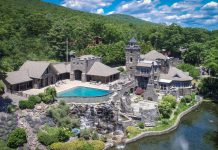From Unwanted and Useless to Rare and Intriguing
By Duncan Forgey, Prudential California Realty
Originally named “Lagunas” by the Native Americans for the two fresh water lagoons in the canyon, this narrow strip of coastal land has history like no other. Lagunas’ Native Americans walked from their canyon village to the beaches, where seafood was plentiful. Life was a virtual paradise for these earliest of residents.
Upon Spanish intrusion, Lagunas was not included in the Mexican land grants of Rancho San Joaquin or Rancho Niguel. It was undesirable and unusable land that simply transitioned the two large ranchos.
After statehood, the lands fell under the guise of the federal government. According to the Timber-Culture Act of the 1870s, under the “160 acres and a mule” principal, land was granted to anyone who would plant 10 acres of trees over 10 years. Laguna’s early families did just that but found living was still very hard for this useless swatch of the California coastline. In 1876, William Brooks sold his 169 acres for $50. Later in 1919, Henry Rogers’ niece sold the land encompassing much of the downtown village for $24,000.
Laguna Beach was too rocky and hilly for agriculture, farming or grazing. It was very pretty but out of the way of the railroad and did not have a good harbor like its neighbor – Newport Beach. It, therefore, had no real commercial value and virtually hibernated until the1920s.
In 1921, Isaac Frazee organized the first Indian Festival, starring Native American singer Chief Yowlacae. Two years later, Wayne Moore started the Community Players, whose first play was Uncle Tom’s Cabin. It was around this time that well known and aspiring artists and writers from throughout the nation met in Laguna Beach and established the famous “round table discussions.” This activity attracted many of the creative minds of the early 20th Century and established this ocean town as a center for the cerebral and forward thinkers of that era. The city of Laguna Beach, with a population of 1,900, voted to incorporate in 1927.
Laguna Beach’s artistic ambience is rooted in these early years. This long tradition has continued right up to today with an abundance of writers, artists and actors selecting Laguna Beach as their hometown. Bette Davis, Ozzie and Harriet Nelson, Rock Hudson, Lorne Green, Mickey Rooney and Rudolph Valentino were all past residents of the town. John Steinbeck wrote “Tortilla Flats” while living at 504 Park Avenue. More recently, Dean Koontz has used Laguna Beach as a backdrop to his suspense and evil in his novel “Tick Tock.”
Another unique symbol of Laguna Beach’s history was its Greeter, or actually, its two Greeters. The tradition started with Joe Lucas who at the turn of the 20th Century met visitors to Laguna as they arrived via stagecoach. His long hair and beard was a carbon copy of the second and most well-known Greeter Eiler Larsen.
Larsen arrived in 1934 after a cross country trip from the east coast. He fell in love with the artsy nature of this woodsy town. He is best remembered all the way into the 1960s for his corner stance on PCH, smiling at the passing automobiles, pointing his finger in a wave-like fashion and yelling “Helloooo!” No other town can boast such a friendly and positive tradition as the Greeter of Laguna Beach.
The first subdivision in Laguna was built in 1887. It consisted of 50-foot wide lots along the ocean front from Laguna Avenue to Sleepy Hollow Lane that sold for $1 a front foot. By 1972, the price had risen to $4,000 a front foot and today it is well over that by tenfold.
Another unique aspect of the neighborhoods in Laguna is the varying styles of architecture that can be found. Eclectic is Laguna’s middle name. Driving the many escalating streets in the city, one can see a “Hansel and Gretel” cottage, next to a charming beach house with a white picket fence, next to a contemporary with lots of glass, angles and lines that spin off in all directions.
Unlike any other community, a large percentage of the homes are vertical in nature. These “cliffhangers” are stuck along the hills like so many barnacles, all with awesome views of the ocean and coastline. View properties are commonplace in Laguna Beach and create the high prices that the town is noted for.
The people of Laguna have a reputation for fighting hard to keep their unique lifestyle. Growth and development in Laguna is not just hard but darn near impossible. Development of the canyon was fought and defeated by the people of Laguna Beach. In the Village, any new construction property use must conform to the strict rules and image desired by the people and the government of the city.
Arts and environment are foremost on the minds of most of the populace. Stiff opposition is quickly aroused and political battles are not uncommon.
Real estate in Laguna Beach ranges from Irvine Cove, Emerald Bay and Smithcliffs, to Bluebird Canyon, Mystic Hills and Alta Vista to the spectacular oceanfront estates that swirl down the coastline standing like sentinels to the pounding waves. Prices in the city start around $800,000, average around $2,000,000 and can reach as high as $31,000,000. To see the ocean in Laguna Beach is definitely a “million dollar view” or probably more.
Even with these prices, Laguna Beach is known as a picturesque little beach “town.” It is an artsy village full of alternative lifestyles. Whether it is for a business executive, an artist, a writer, a Woodstock holdover or anyone else, Laguna Beach will open its heart with a smile and a “Larsenesque” style “Helooo.”
The town’s history is full of incidents which include rum running, whaling, horse racing and Chinese coolie smuggling and add that to its mixture of Mormons, Native Americans, artists, actors, gays and hippies, you have the recipe for something out of the extraordinary. Laguna Beach is visually spectacular and culturally rare. It is by no means ordinary.
Reach Duncan Forgey at Prudential California Realty at forgey5000@yahoo.com.



